
Nataraja also known as Adalvallan is a depiction of the Hindu god Shiva as the divine cosmic dancer. His dance is called the tandava. The pose and artwork are described in many Hindu texts such as the Tevaram and Thiruvasagam in Tamil and the Amshumadagama and Uttarakamika agama in Sanskrit and the Grantha texts. The dance murti featured in all major Hindu temples of Shaivism, and is a well-known sculptural symbol in India and popularly used as a symbol of Indian culture, as one of the finest illustrations of Hindu art. This form is also referred to as Kuththan, Sabesan, and Ambalavanan in various Tamil texts.

The Ardhanarishvara, is a form of the Hindu deity Shiva combined with his consort Parvati. Ardhanarishvara is depicted as half-male and half-female, equally split down the middle. The right half is usually the male Shiva, illustrating his traditional attributes.

Sharabha or Sarabha is a part-lion and part-bird beast in Hindu mythology, who is described eight-legged and more powerful than a lion or an elephant, possessing the ability to clear a valley in one jump. In later literature, Sharabha is described as an eight-legged deer.

Dakshinamurthy is an aspect of the Hindu god Shiva as a guru (teacher) of all types of knowledge. This aspect of Shiva, as the original guru, is his personification as the supreme or the ultimate awareness, understanding and knowledge. This form represents Shiva as a teacher of yoga, music and wisdom, and giving exposition on the shastras. He is worshipped as the god of wisdom, complete and rewarding meditation. According to Hindu scriptures, if a person doesn't have a guru, they can consider and worship Dakshinamurthy as their guru. Eventually they will be blessed with a self-realised human guru, if they are worthy.
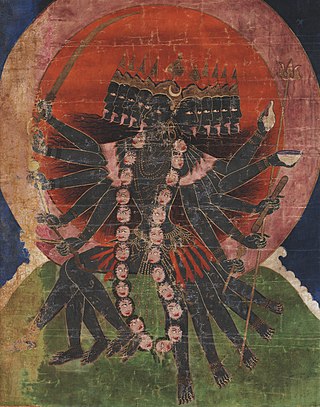
Mahakali is the Hindu goddess of time and death in the goddess-centric tradition of Shaktism.

Heramba, also known as Heramba Ganapati, is a five-headed iconographical form of the Hindu god Ganesha (Ganapati). This form is particularly popular in Nepal. This form is important in Tantric worship of Ganesha. He is one of the most popular of the thirty-two forms of Ganesha.

A kapala is a skull cup used as a ritual implement (bowl) in both Hindu Tantra and Buddhist Tantra (Vajrayana). Especially in Tibet, they are often carved or elaborately mounted with precious metals and jewels.

Ganesha, also known as Ganapati,Vinayaka, and Pillaiyar, is one of the best-known and most worshipped deities in the Hindu pantheon and is the Supreme God in Ganapatya sect. His image is found throughout India. Hindu denominations worship him regardless of affiliations. Devotion to Ganesha is widely diffused and extends to Jains and Buddhists and includes Nepal, Sri Lanka, Thailand, Indonesia, Singapore, Malaysia, Philippines, and Bangladesh and in countries with large ethnic Hindus populations including Fiji, Guyana, Mauritius, and Trinidad and Tobago.
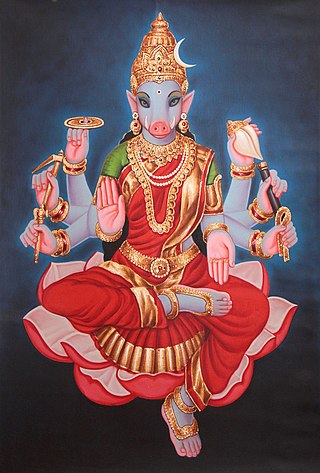
Varahi is one of the Matrikas, a group of seven mother goddesses in the Hindu religion. Bearing the head of a sow, Varahi is the shakti of Varaha, the boar avatar of the god Vishnu. In Nepal, she is called Barahi. In Rajasthan and Gujarat, she is venerated as Dandini.
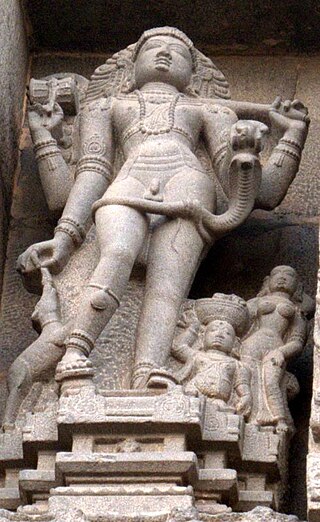
Bhikshatana or Bhikshatana-murti is an aspect of the Hindu god Shiva as the "Supreme mendicant" or the "Supreme Beggar". Bhikshtana is depicted as a nude four-armed man adorned with ornaments who holds a begging bowl in his hand and is followed by demonic attendants.
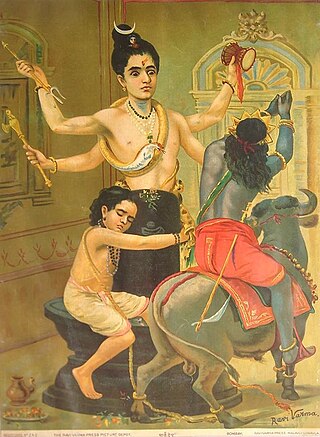
Kalantaka or Kalinjar is an aspect of the Hindu god Shiva as the Conqueror of Time and Death, itself personified by the god Yama. He is depicted as defeating or killing Yama when the latter comes to take the life of Shiva's devotee Markandeya. Shiva is often depicted as dancing on Death, personified by Yama. This incident is believed as happened at Triprangode, Tirur, Malappuram district, Kerala where the Kalasamharamurthy Temple is situated. Another chief temple dedicated to Kalantaka is situated at Thirukkadavoor, Tamil Nadu of South India, however the Kalantaka icon is found sculpted in many Shiva temples in the South.
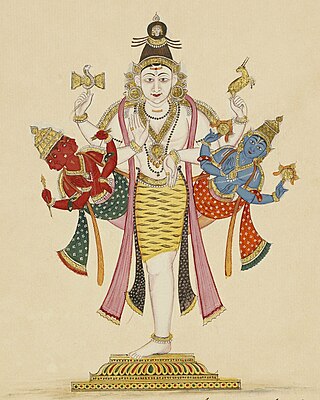
Ekapada refers to a one-footed aspect of the Hindu god Shiva. This aspect is primarily found in South India and Orissa, but also occasionally in Rajasthan and Nepal. The Ekapada is primarily represented in three iconographical forms. In the Ekapada-murti form, he is depicted as one-legged and four-armed. In the Ekapada-Trimurti form, he is depicted with the torsos of the deities Vishnu and Brahma, which together with Shiva form the Hindu Trinity (Trimurti) emanating from his sides, waist upwards and with one leg; however, sometimes, besides the central one leg of Shiva, two smaller legs of Vishnu and Brahma emerge from the sides. While some scriptures also call the latter configuration Ekapada-Trimurti, some refer it to as Tripada-Trimurti. In Orissa, where Ekapada is considered an aspect of Bhairava—the fearsome aspect of Shiva—the iconography of Ekapada-murti becomes more fierce, with motifs of blood sacrifice. This aspect is called Ekapada Bhairava.

Uttaresvara Siva Temple is a 12th-century Hindu temple dedicated to Lord Siva located in Bhubaneswar, Odisha, India.

Kalyanasundara, also spelt as Kalyansundar and Kalyana Sundara, and known as Kalyanasundara-murti, Vaivahika-murti and Panigrahana-murti ( पाणिंग्रहण-मूर्ति), is the iconographical depiction of the wedding of the Hindu deities Shiva and Parvati. The couple are often depicted performing the panigrahana ritual of a Hindu wedding, where the groom accepts the bride by taking her right hand in his.

Ravananugraha or Ravananugraha-murti is a benevolent aspect of the Hindu god Shiva, depicted seated on his abode Mount Kailash with his consort Parvati, while the rakshasa-king (demon-king) Ravana of Lanka attempts to uproot it.

Vinayaki (Vināyakī) is an elephant-headed Hindu goddess. Her mythology and iconography are not clearly defined. Little is told about her in Hindu scriptures and very few images of this deity exist.
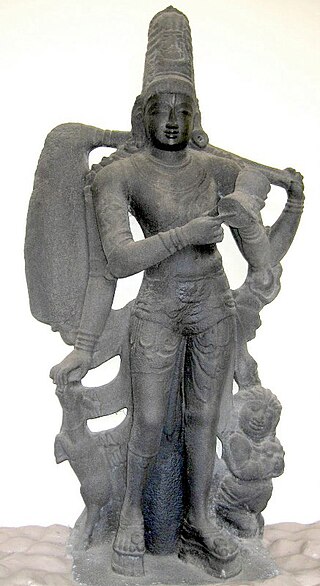
Kankala-murti, also known as Kankala ("skeleton") or Kankala-Bhairava, is an iconographical form of the Hindu god Shiva. He is often associated with a fearsome aspect of Shiva, Bhairava and thus considered the latter's aspect too. Kankalamurti is popular in South Indian temples of Shiva, but almost unknown in North India. He is described in legends to have defeated and slain Vishnu's army-chief and gate-keeper Vishvaksena or Vishnu's avatar Vamana. He is depicted as a four-armed man with a kankala-danda (skeleton-staff) in his hand and followed by demonic attendants and love-sick women.

Mundamala, also called kapalamala or rundamala, is a garland of severed human heads and/or skulls, in Hindu iconography and Tibetan Buddhist iconography. In Hinduism, the mundamala is a characteristic of fearsome aspects of the Hindu Divine Mother and the god Shiva; while in Buddhism, it is worn by wrathful deities of Tibetan Buddhism.

Sadasiva, is the Supreme Being, also known as Paramashiva, in the Shaiva Siddhanta tradition of Shaivism. Sadasiva is the omnipotent, subtle, luminous absolute, the highest manifestation of Shiva. Sadasiva blesses with Anugraha and Vilaya, or grace and obscuration of Pasha, which are the fourth and fifth of the Panchakritya, or "five holy acts" of Shiva. Sadasiva is usually depicted having five faces and ten hands, is also considered one of the 25 Maheshwara murtams of Shiva. Shiva Agamas conclude that the Shiva Lingam, especially the Mukhalingam, is another form of Sadasiva.
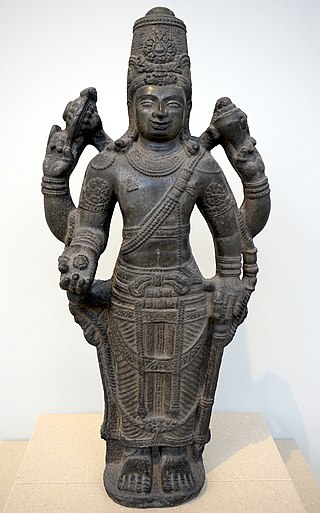
Chaturbhuja is a concept in Hindu iconography in which a deity is depicted with four arms. Several Hindu deities are often portrayed with four arms in their iconography, featured in Hindu literature. The iconography of four arms is regarded to symbolise divinity and power, as well as dominion over the four quarters of the universe.























